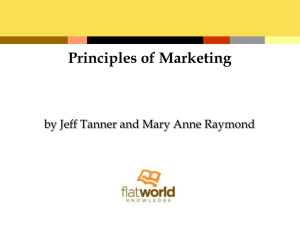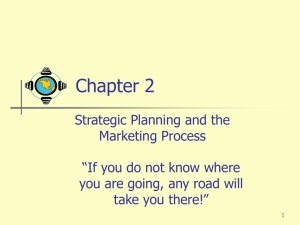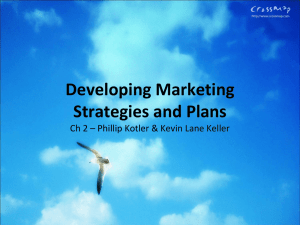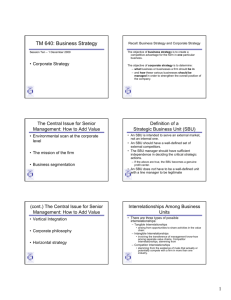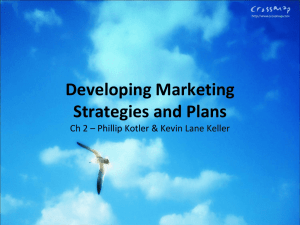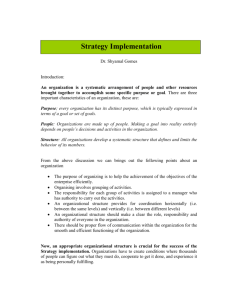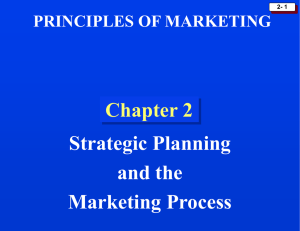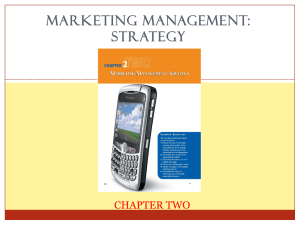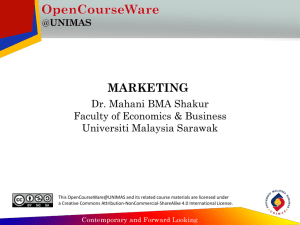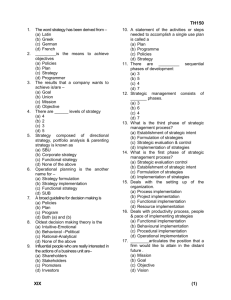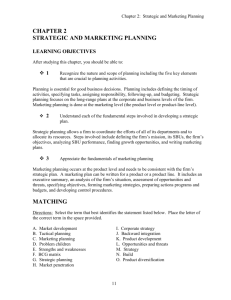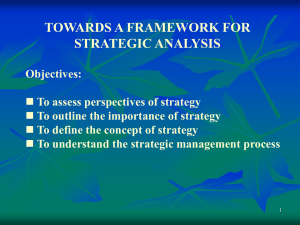CHAPTER 3 - courses.psu.edu
advertisement
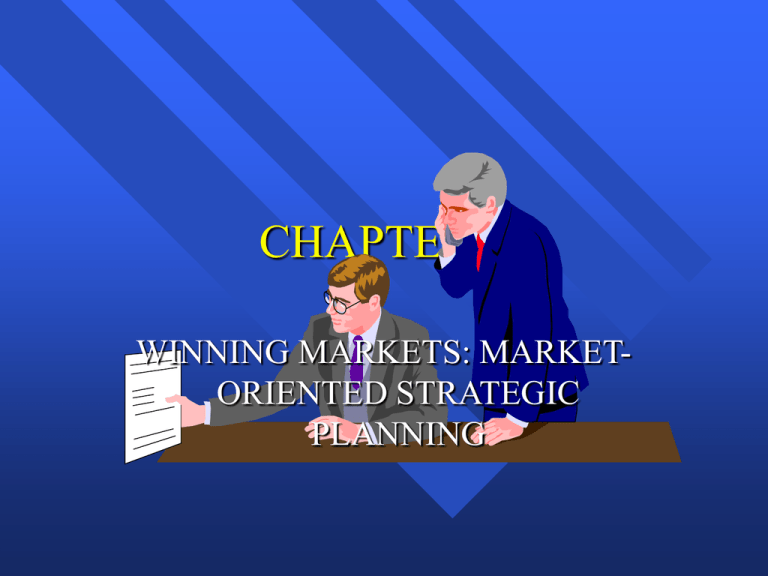
CHAPTER 3 WINNING MARKETS: MARKETORIENTED STRATEGIC PLANNING Important Topics of This Chapter Characteristics of Corporate Planning: » » » » Vision Mission SBU Product Portfolio Models: BCG Model GE Model Strategies for Planning A New Business Business Strategic Planning The Marketing Process Contents of A Marketing Plan CORPORATE AND DIVISION STRATEGIC PLANNING Defining the Mission: » » » » » History Preferences Environment Resources Distinctive Competencies. Characteristics of Mission Statements: » » Goals Company policies with suppliers, customers. etc. CORPORATE AND DIVISION STRATEGIC PLANNING Characteristics of Mission Statement (cont.): » Competitive scope: Industry, product, competence, market-segment, vertical, geographical Establishing Strategic Business Units (SBU): » Single business: » Satisfies its own set of competitors: » customer group customer needs Single managers responsible for planning and technology improvements DIVISION STRATEGIC PLANNING (CONT.) Assigning Resources to Each SBU: » Boston Consulting Group Model(BCG): » Strategies: » Market share and market growth Build-increase market share Hold-maintain market share Harvest-increasing short-term cash flow Divest-liquidation. Mistakes: expect all SBU will have same growth pattern, very little cash retained for cash cows. Analyzing Current SBU’s: Boston Consulting Group Model High High Stars • High growth & share • Profit potential • May need heavy investment to grow Cash Cows Low Market Growth Rate Relative Market Share Low Question Marks • High growth, low share • Build into Stars/ phase out • Requires cash to hold market share Dogs • Low growth, high share • Low growth & share • Established, successful • Low profit potential SBU’s •Produces cash DIVISION STRATEGIC PLANNING (CONT.) The General Electric Model(GE): » Market Attractiveness and Business Strengths. Critiques of Portfolio Models: » Positives: » help to understand economies of business better quality of plans may be improved communication with top management may be improved. pinpoint information gab help to eliminate weaker businesses open opportunities to invest to more profitable businesses. Negatives: too mach emphasis to market share, Can be manipulated to produce desired location fail to delineate synergy between two or more business. Industry Attractiveness Analyzing Current SBU’s: GE Strategic Business-Planning Grid Business Strength Strong Average Weak C High A Medium B Low D PLANNING NEW BUSINESSES Intensive Growth: » Product/market expansion grit Market Penetration Market Development\Product Development Integrative Growth: » » » Backward Integration Forward Integration Horizontal Integration Developing Growth Strategies Product/ Market Expansion Grid Existing Products Existing Markets 1. Market Penetration New Markets 2. Market Development New Products 3. Product Development 4. Diversification PLANNING NEW BUSINESSES Diversification Growth: » Related industries » Unrelated Industries concentric diversification horizontal diversification Conglomerate diversification Downsizing Older Businesses: » Pruning. BUSINESS STRATEGIC PLANNING Business Vision/Mission SWOT ANALYSIS: – External Environmental Analysis: » Opportunity and Treat Analysis Marketing Opportunity-success probability: » Environmental Treat-probability of occurrence: Ideal business-opportunities are high and treat is low Speculative business-high on both opportunities and treat Mature business-low in opportunities and low in treat Troubled business-low in opportunities and high in treats » Internal Environmental Analysis: Strength and Weaknesses: BUSINESS STRATEGIC PLANNING (CONT.) Goal Formulation: » » MBO Profit (short-term profit or long-term growth) vs. nonprofit goals, or high growth Vs low risk. ROI Realistic goals Strategy Formulation: » Cost Leadership: » Differentiation: » learning curve service, quality, technology Focus: target market BUSINESS STRATEGIC PLANNING (CONT.) Strategic Alliances: » » » » product/service alliances promotional alliances logistic alliances pricing collaborations: Program Formulation: » airlines,hotels and car rental supporting programs-R&D Implementation Feedback and Control THE MARKETING PROCESS Value Delivery Process: – Production process: » Strategic Marketing: » Marketing is at the top – segmentation – targeting – positioning Tactical Marketing Provide and communicate the value-Japanese approach: – zero Customer feedback – zero product-improvement time – zero purchasing time(JIT) – zero set-up time – zero defects. THE MARKETING PROCESS (CONT.) Analyzing Marketing Opportunities: » Marketing research : Developing Marketing Strategies: » Differentiation and positioning Planning Marketing Programs: » Marketing mix: Macro/Micro environment Consumer and business markets. Product, Price, Promotion and Place Managing Marketing Effort: » Implementation of marketing programs CONTENTS OF MARKETING PLAN Executive Summary Current Marketing Situation: » » » » » Market Product Competition Distribution Macro-environment CONTENTS OF MARKETING PLAN (CONT.) Opportunity and Issue Analysis: » » » Opportunities/Treats Analysis. Strengths/Weaknesses Analysis. Issue Analysis. Objectives/Goals: » » Financial. Marketing. CONTENTS OF MARKETING PLAN (CONT.) Marketing Strategy: » Targeting, positioning: product price promotion distribution, service, R&D and marketing research. Action Programs Projected Profit-and-Loss Statement Controls MARKETING PLANNING IN THE 2000s Customer and Competitor Oriented More Realistic Team Approach Top Management Involvement Continuing Process Cover shorter term (one year and so) Some Take Seriously, others use as a guideline
